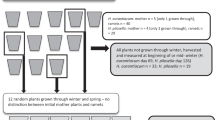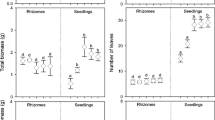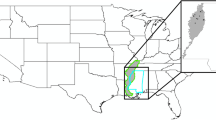Abstract
Aeschynomene virginica is a rare annual plant found in freshwater tidal wetlands of the eastern United States. We hypothesized that standing vegetation and water inundation were two important environmental factors in its population dynamics. To test these hypotheses, we sowed seeds into plots with undisturbed vegetation or plots with all aboveground vegetation removed in 1998 and 1999. Presence/absence of seedlings was noted and seedling survival to reproduction, final size, and seed set were measured throughout both growing seasons. Seedling establishment from germination to the first true leaf stage increased with decreasing water depth. Vegetation removal plots had greater seedling establishment, higher seedling survival, and higher seed set per plant than non-removal plots. In a greenhouse study designed to test the effects of water level on seed germination and seedling establishment, no seedlings established in submerged soils, and seed germination and seedling establishment were lower in waterlogged soil than in wet soil. Physical stress associated with deeper water likely limits the distribution of A. virginica to higher elevations, where seeds that colonize patches with low vegetative cover are more likely to produce reproductive adults that produce more seeds relative to patches with established vegetation. A. virginica appears to be a fugitive species specializing on open habitat patches in tidal wetlands. This species may be dependent on disturbances for population establishment and maintenance.
Similar content being viewed by others
References
Armstrong R.A. 1976. Fugitive species: experiments with fungi and some theoretical considerations. Ecology 57: 953–963.
Baldwin A.H., McKee K.L. and Mendelssohn I.H. 1996. The in-fluence of vegetation, salinity, and inundation on seed banks of oligohaline coastal marshes. American Journal of Botany 83: 470–479.
Baskin J.M. and Baskin C.C. 1995. Seed germination studies of Aeschynomene virginica: final report to the Virginia Department of Agriculture and Consumer Services. School of Biological Sciences, University of Kentucky, Lexington, Kentucky, USA.
Bertness M.D., Gough L. and Shumway S.W. 1992. Salt tolerances and the distribution of fugitive salt marsh plants. Ecology 73: 1842–1851.
Bornette G., Amoros C. and LaMouroux N. 1998. Aquatic plant diversity in riverine wetlands: the role of connectivity. Freshwater Biology 39: 267–283.
Campbell J.J.N., Evans M., Medley M.E. and Taylor N.L. 1988. Buffalo clovers in Kentucky (Trifolium stonloniferum and T.reflexum): historical records, presettlement environment, rediscovery, endangered status, cultivation and chromosome number.Rhodora 90: 399–418.
Davison S.E. and Bruderle L.P. 1984. Element stewardship abstract for Aeschynomene virginica – sensitive joint-vetch. The Nature Conservancy, Arlington, Virginia, USA.
Ferren W.R.J. and Schuyler A.E. 1980. Intertidal vascular plants of river systems near Philadelphia. Proceedings of the Academy of Natural Sciences of Philadelphia 132: 86–120.
Gawler S.C., Waller D.M. and Menges E.S. 1987. Environmental factors affecting establishment and growth of Pedicularis furbishiae, a rare endemic of the St. John River Valley, Maine.Bulletin of the Torrey Botanical Society 114: 280–292.
Gleason H.A. and Cronquist A. 1991. Manual of vascular plants of northeastern United States and adjacent Canada. New York Botanical Garden, New York.
Griffith A.B. 2002. The population dynamics of Aeschynomene virginica, a rare, wetland annual. PhD Dissertation, University of Maryland, College Park, USA.
Hartman J.M. 1988. Recolonization of small disturbance patches in a New England salt marsh. American Journal of Botany 75: 1625–1631.
Horn H.S. and MacArthur R.H. 1972. Competition among fugitive species in a harlequin environment. Ecology 53: 749–752.
Hutchinson G.E. 1951. Copedology for the ornithologist. Ecology 32: 571–577.
Keough J.R., Thompson T.A., Guntenspergen G.R. and Wilcox D.A. 1999. Hydrogeomorphic factors and ecosystem responses in coastal wetlands of the Great Lakes. Wetlands 19: 821–834.
Kirkman L.K. and Sharitz R.R. 1994. Vegetation disturbance and maintenance of diversity in intermittently flooded Carolina Bays in South Carolina. Ecological Applications 4: 177–188.
Leck M.A. and Simpson R.L. 1993. Seeds and seedlings of the Hamilton marshes, a Delaware River tidal freshwater wetland.Proceedings of the Academy of Natural Sciences of Philadelphia 144: 267–281.
Leck M.A. and Simpson R.L. 1994. Tidal freshwater wetland zonation: seed and seedling dynamics. Aquatic Botany 47: 61–75.
Leck M.A. and Simpson R.L. 1995. Ten-year seed bank and vegetation dynamics of a tidal freshwater marsh. American Journal of Botany 82: 1547–1557.
Levins R. and Culver D. 1972. Regional coexistence of species and competition between rare species. The Proceedings of the National Academy of Science 68: 1246–1248.
Lynch J.J., Ted O.N. and Lay D.W. 1947. Management significance of damage by geese and muskrats to Gulf coast marshes. The Journal of Wildlife Management 11: 51–76.
McKee K.L. and Baldwin A.H. 1999. Disturbance regimes in North American wetlands. In: Walker L.R. (ed.), Ecosystems of disturbed ground. Elsevier, New York, pp. 331–363.
Odum W.E. 1988. Comparative ecology of tidal freshwater and salt marshes. Annual Review of Ecology and Systematics 19: 147–176.
Odum W.E., Smith T.J.I., Hoover J.K. and McIvor C.C. 1984. The ecology of tidal freshwater marshes of the United States East Coast: a community profile. University of Virginia, Charlottesville, Virginia, USA.
Parker V.T. and Leck M.A. 1979. Seed dispersal and seedling survival in relation to zonation patterns in a freshwater tidal marsh.Bulletin of the Ecological Society of America 60: 133.
Parker V.T. and Leck M.A. 1985. Relationships of seed banks to plant distribution patterns in a freshwater tidal wetland. American Journal of Botany 72: 161–174
SAS Institute Inc. 1996. Statistical analysis system, Release 6.12.SAS Institute Inc., Cary, North Carolina, USA.
Seabloom E.W., van der Valk A.G. and Moloney K.A. 1998. The role of water depth and soil temperature in determining initial composition of prairie wetland coenoclines. Plant Ecology 138: 203–216.
Simpson R.L., Good R.E., Leck M.A. and Whigham D.F. 1983.The ecology of freshwater tidal wetlands. BioScience 33: 255–259.
Smith M., Wu Y. and Green O. 1993. Effect of light and waterstress on photosynthesis and biomass production in Boltonia decurrens (Asteraceae), a threatened species. American Journal of Botany 80: 859–864.
Sokal R.R. and Rohlf F.J. 1987. Introduction to biostatistics. 2nd edn. Freeman and Company, New York.
Sousa W.P. 1984. The role of disturbance in natural communities.Annual Review of Ecology and Systematics 15: 353–391.
Squires L. and van der Valk A.G. 1992. Water-depth tolerances of the dominant emergent macrophytes of the Delta Marsh, Manitoba.Canadian Journal of Botany 70: 1860–1867.
Stoecker M.A., Smith M. and Melton E.D. 1995. Survival and aerenchyma development under flooded conditions of Boltonia decurrens, a threatened floodplain speceis and Conyza canadensis, a widely distributed competitor.
U.S. Fish and Wildlife Service 1992. Endangered and threatened wildlife and plants; determination of threatened status for the sensitive joint-vetch (Aeschynomene virginica). Federal Register 57: 21569–21574.
U.S. Fish and Wildlife Service 1995. Sensitive joint-vetch (Aeschynomene virginica) recovery plan. US Fish and Wildlife Service, Hadley, Massachusetts, USA.
Whigham D.F., McCormick J., Good R.E. and Simpson R.L. 1978.Biomass and primary production in freshwater tidal wetlands of the Middle Atlantic Coast. In: Good R.E., Whigham D.F. and Simpson R.L. (eds), Freshwater wetlands. Academic Press, New York, pp. 3–20.
Wilson D.E. and Reeder D.M. 1993. Mammal species of the world: a taxonomic and geographic reference. Smithsonian Institution Press, Washington, DC, USA.
Author information
Authors and Affiliations
Corresponding author
Rights and permissions
About this article
Cite this article
Griffith, A.B., Forseth, I.N. Establishment and reproduction of Aeschynomene virginica (L.) (Fabaceae) a rare, annual, wetland species in relation to vegetation removal and water level. Plant Ecology 167, 117–125 (2003). https://doi.org/10.1023/A:1023952907092
Issue Date:
DOI: https://doi.org/10.1023/A:1023952907092




